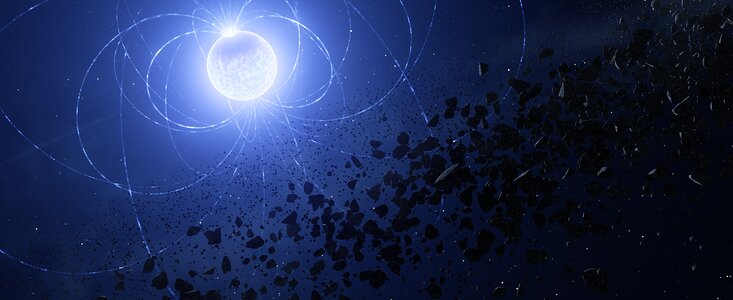Komunikat prasowy
Gwiezdny kanibal z metalową blizną
26 lutego 2024
Gdy gwiazda taka jak Słońce kończy swoje życie, może pochłonąć otaczające ją planety i planetoidy, które się z nią zrodziły. Korzystając z Bardzo Dużego Teleskopu (VLT) w Chile, należącego do Europejskiego Obserwatorium Południowego (ESO), naukowcy po raz pierwszy odkryli unikalną sygnaturę tego procesu – bliznę odciśniętą na powierzchni białego karła. Wyniki opublikowano dzisiaj w "The Astrophysical Journal Letters".
„Dobrze wiadomo, że niektóre białe karły – powoli stygnące „piece” gwiazd, takich jak Słońce – kanibalizują fragmenty swoich układów planetarnych. Odkryliśmy, że pole magnetyczne gwiazdy odgrywa kluczową rolęw tym procesie, dając efekt w postaci blizny na powierzchni białego karła” mówi Stefano Bagnulo, astronom z Armagh Observatory and Planetarium w Irlandii Północnej (Wielka Brytania), pierwszy autor badań.
Blizna, którą obserwował zespół badawczy to nagromadzenie metali odciśniętę na powierzchni białego karła WD 0816-310, obiektu o rozmiarach Ziemi, będącego pozostałością gwiazdy podobnej do Słońca, chociaż nieco bardziej masywnej. „Pokazaliśmy, że metale te pochodzą z fragmentów planetarnych o rozmiarach takich jak Westa lub większych, czyli około 500 kilometrów średnicy. Westa to druga pod względem wielkości planetoida w Układzie Słonecznym” tłumaczy Jay Farihi, profesor na University College London (Wielka Brytania), współautor badań.
Obserwacje dostarczyły także wskazówek, w jaki sposób gwiazd otrzymała metalową bliznę. Grupa badawcza zauważyła, że siła wykrywania metali zmienia się wraz z obrotem gwiazdy, co sugeruje, iż są one skoncentrowane na określonym obszarze powierzchni białego karła, a nie rozmieszczone na nim równomiernie. Odkryto także, iż zmiany te są zsynchronizowane ze zmianami pola magnetycznego białego karła, co z kolei wskazuje, że metalowa blizna znajduje się na jednym z biegunów magnetycznych. Łącząc te wskazówki razem, można stwierdzić, iż to pole magnetyczne skierowało metale na gwiazdę, tworząc bliznę [1].
“Co zaskakujące, materia nie była równomiernie wymieszana na powierzchni gwiazdy, tak jak przewidywała teoria. Zamiast tego blizna jest skoncentrowanym obszarem materii planetarnej, utrzymywanej w miejscu przez to samo pole magnetyczne, które kierowało spadającymi fragmentami” mówi współautor John Landstreet, profesor na Western Universit (Kanada), który jest również afilowany w Armagh Observatory and Planetarium. „Do tej pory nie widziano nicznego podobnego.”
Aby dojść do tych wniosków, zespół użył „szwajcarskiego scyzoryka” w postaci instrumentu na VLT o nazwie FORS2, który pozwolił wykryć metalową bliznę i połączyć ją z polem magnetycznym gwiazdy. „ESO posiada unikatowe połączenie możliwości potrzebnych do obserwacji słabych obiektów, takich jak białe karły, oraz czułego pomiaru gwiezdnych pól magnetycznych” tłumaczy Bagnulo. W swoich badaniach naukowcy oparli się także na archiwalnych danych z innego instrumentu VLT, o nazwie X-shooter, aby potwierdzić swoje ustalenia.
Wykorzystując moc takich obserwacji, astronomowie mogą poznać ogólny skład egzoplanet, czyli planet krążących wokół gwiazd poza Układem Słonecznym. Te wyjątkowe badania pokazują także, jak układy planetarne mogą pozostawać dynamicznie aktywne nawet po „śmierci”.
Uwagi
[1] Wcześniej astronomowie obserwowali liczne białe karły zanieczyszczone metalami, które były rozproszone na powierzchni gwiazdy. Wiadomo, że pochodzą one ze zniszczonych planet lub planetoid, które znalazły się zbyt blisko gwiazdy, poruszając się po orbitach podobnych do komet muskających gwiazdę w Układzie Słonecznym. Jednak w przypadku WD 0816-310, zespół badawczy jest pewny, że odparowany materiał został zjonizowany i skierowany do biegunów magnetycznych poprzez pole magnetyczne białego karła. Proces ten ma podobieństwa do powstawania zórz polarnych na Ziemi i na Jowiszu.
Więcej informacji
Wyniki badań zaprezentowano w artykule pt. “Discovery of magnetically guided metal accretion onto a polluted white dwarf”, który ukaże się w The Astrophysical Journal Letters (doi:10.3847/2041-8213/ad2619).
Skład zespołu badawczego: Stefano Bagnulo (Armagh Observatory & Planetarium, UK [Armagh]), Jay Farihi (Department of Physics and Astronomy, University College London, UK), John D. Landstreet (Armagh; Department of Physics & Astronomy, Western University, Canada) oraz Colin P. Folsom (Tartu Observatory, University of Tartu, Estonia).
Europejskie Obserwatorium Południowe (ESO) umożliwia naukowcom z całego świata na odkrywanie tajemnic Wszechświata z korzyścią dla nas wszystkich. Projektujemy, budujemy i zarządzamy światowej klasy obserwatoriami naziemnymi – których astronomowie używają do odpowiadania na ciekawe pytania i szerzenia fascynacji astronomią – a także promujemy międzynarodową współpracę w astronomii. Ustanowione w 1962 roku jako organizacja międzynarodowa, ESO jest wspierane przez 16 krajów członkowskich (Austria, Belgia, Czechy, Dania, Finlandia, Francja, Hiszpania, Irlandia, Holandia, Niemcy, Polska, Portugalia, Szwajcaria, Szwecja, Wielka Brytania oraz Włochy), a także Chile jako kraj gospodarz, oraz Australię jako strategicznego partnera. Siedziba ESO, a także jego centrum popularyzacji nauki i planetarium (ESO Supernova) znajdują się w pobliżu Monachium w Niemczech, natomiast chilijska pustynia Atakama – niesamowite miejsce z wyjątkowymi warunkami do obserwacji nieba – jest domem dla naszych teleskopów. ESO zarządza trzema lokalizacjami obserwacyjnymi w Chile: La Silla, Paranal i Chajnantor. W Paranal ESO posiada teleskop VLT (Very Large Telescope – Bardzo Duży Teleskop) oraz dwa teleskopy do przeglądów nieba. VISTA pracuje w podczerwieni, VLT Survey Telescope w zakresie widzialnym. W Paranal ESO zarządza także południowym obserwatorium CTA (Cherenkov Telescope Array South) – największym na świecie i najbardziej czułym obserwatorium promieniowania gamma. Wspólnie z międzynarodowymi partnerami ESO zarządza także radioteleskopami APEX i ALMA, które są instrumentami do obserwacji nieba w zakresach milimetrowym i submilimetrowym. Na Cerro Armazones, niedaleko Paranal, budujemy „największe oko świata na niebo”, czyli Ekstremalnie Wielki Teleskop (Extremely Large Telescope, ELT). Nasza działalność w Chile jest zarządzania z biur ESO w Santiago, gdzie współpracujemy też z chilijskimi partnerami.
Linki
- Publikacja naukowa
- Zdjęcia VLT
- Dla dziennikarzy: subscribe to receive our releases under embargo in your language
- Dla naukowców: got a story? Pitch your research
Kontakt
Stefano Bagnulo
Armagh Observatory and Planetarium
Armagh, UK
Tel.: +44 (0)28 3752 3689
E-mail: Stefano.Bagnulo@Armagh.ac.uk
Jay Farihi
Department of Physics & Astronomy, University College London
London, UK
E-mail: j.farihi@ucl.ac.uk
John Landstreet
Department of Physics & Astronomy, University of Western Ontario and Armagh Observatory and Planetarium
London and Armagh, Canada and UK
E-mail: jlandstr@uwo.ca
Bárbara Ferreira
ESO Media Manager
Garching bei München, Germany
Tel.: +49 89 3200 6670
Tel. kom.: +49 151 241 664 00
E-mail: press@eso.org
Krzysztof Czart (Kontakt dla mediów Polska)
Sieć Popularyzacji Nauki ESO
oraz Urania - Postępy Astronomii
Toruń, Polska
Tel.: +48 513 733 282
E-mail: eson-poland@eso.org
O komunikacie
| Komunikat nr: | eso2403pl |
| Nazwa: | WD 0816-310 |
| Typ: | Milky Way : Star : Evolutionary Stage : White Dwarf |
| Facility: | Very Large Telescope |
| Instrumenty: | FORS2, X-shooter |
| Science data: | 2024ApJ...963L..22B |
Our use of Cookies
We use cookies that are essential for accessing our websites and using our services. We also use cookies to analyse, measure and improve our websites’ performance, to enable content sharing via social media and to display media content hosted on third-party platforms.
ESO Cookies Policy
The European Organisation for Astronomical Research in the Southern Hemisphere (ESO) is the pre-eminent intergovernmental science and technology organisation in astronomy. It carries out an ambitious programme focused on the design, construction and operation of powerful ground-based observing facilities for astronomy.
This Cookies Policy is intended to provide clarity by outlining the cookies used on the ESO public websites, their functions, the options you have for controlling them, and the ways you can contact us for additional details.
What are cookies?
Cookies are small pieces of data stored on your device by websites you visit. They serve various purposes, such as remembering login credentials and preferences and enhance your browsing experience.
Categories of cookies we use
Essential cookies (always active): These cookies are strictly necessary for the proper functioning of our website. Without these cookies, the website cannot operate correctly, and certain services, such as logging in or accessing secure areas, may not be available; because they are essential for the website’s operation, they cannot be disabled.
Functional Cookies: These cookies enhance your browsing experience by enabling additional features and personalization, such as remembering your preferences and settings. While not strictly necessary for the website to function, they improve usability and convenience; these cookies are only placed if you provide your consent.
Analytics cookies: These cookies collect information about how visitors interact with our website, such as which pages are visited most often and how users navigate the site. This data helps us improve website performance, optimize content, and enhance the user experience; these cookies are only placed if you provide your consent. We use the following analytics cookies.
Matomo Cookies:
This website uses Matomo (formerly Piwik), an open source software which enables the statistical analysis of website visits. Matomo uses cookies (text files) which are saved on your computer and which allow us to analyze how you use our website. The website user information generated by the cookies will only be saved on the servers of our IT Department. We use this information to analyze www.eso.org visits and to prepare reports on website activities. These data will not be disclosed to third parties.
On behalf of ESO, Matomo will use this information for the purpose of evaluating your use of the website, compiling reports on website activity and providing other services relating to website activity and internet usage.
Matomo cookies settings:
Additional Third-party cookies on ESO websites: some of our pages display content from external providers, e.g. YouTube.
Such third-party services are outside of ESO control and may, at any time, change their terms of service, use of cookies, etc.
YouTube: Some videos on the ESO website are embedded from ESO’s official YouTube channel. We have enabled YouTube’s privacy-enhanced mode, meaning that no cookies are set unless the user actively clicks on the video to play it. Additionally, in this mode, YouTube does not store any personally identifiable cookie data for embedded video playbacks. For more details, please refer to YouTube’s embedding videos information page.
Cookies can also be classified based on the following elements.
Regarding the domain, there are:
- First-party cookies, set by the website you are currently visiting. They are stored by the same domain that you are browsing and are used to enhance your experience on that site;
- Third-party cookies, set by a domain other than the one you are currently visiting.
As for their duration, cookies can be:
- Browser-session cookies, which are deleted when the user closes the browser;
- Stored cookies, which stay on the user's device for a predetermined period of time.
How to manage cookies
Cookie settings: You can modify your cookie choices for the ESO webpages at any time by clicking on the link Cookie settings at the bottom of any page.
In your browser: If you wish to delete cookies or instruct your browser to delete or block cookies by default, please visit the help pages of your browser:
Please be aware that if you delete or decline cookies, certain functionalities of our website may be not be available and your browsing experience may be affected.
You can set most browsers to prevent any cookies being placed on your device, but you may then have to manually adjust some preferences every time you visit a site/page. And some services and functionalities may not work properly at all (e.g. profile logging-in, shop check out).
Updates to the ESO Cookies Policy
The ESO Cookies Policy may be subject to future updates, which will be made available on this page.
Additional information
For any queries related to cookies, please contact: pdprATesoDOTorg.
As ESO public webpages are managed by our Department of Communication, your questions will be dealt with the support of the said Department.



